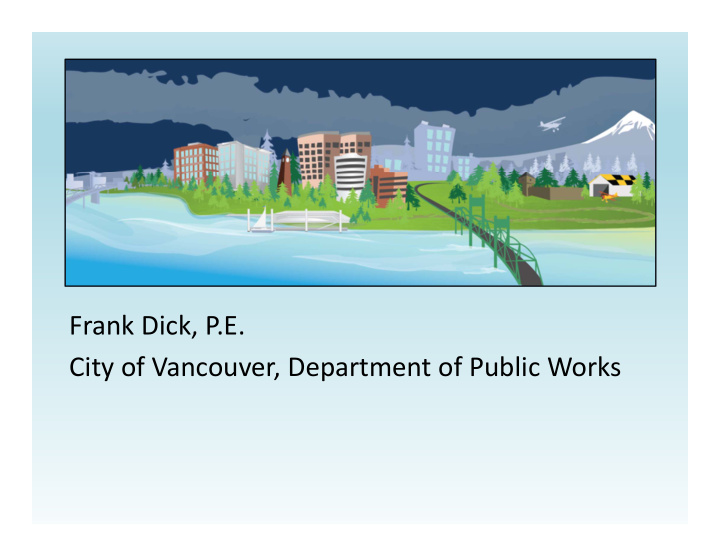



Frank Dick, P.E. City of Vancouver, Department of Public Works
Frank’s Reason
Claims / Disclaims Travel My time my dime NACWA Work Off Time City of Vancouver Interpretations, Opinions are Mine NACWA ‐ WEF ‐ APWA International Organizations Manufacturers
Characteristics of Wipes Working with Manufacturers Disintegration and the Reynolds Number U.S. and world efforts
What We Find in Clogs (Paper / fiber products)
What Wipes are Made of and Their Properties Cellulose / pulp fibers Rayon or Lyocell – regenerated cellulose fibers Typically put together using spunlace or hydroentanglement
Wet Inside Package Water based solutions to stabilize structure / strength Lotions and additives
Dry & Wet Strength
Disintegration & The Reynolds Number
When and Wear a Wipe Breaks Apart Hits water – chemical / ion trigger Toilet – mechanical forces Flow through sewers – hydraulic/mechanical forces Pumps – mechanical forces (too late) Screens – mechanical forces Never
Slosh Box – Reynold’s Number Correlation for TURBULENCE in a Pipe Re = R h V ρ / µ Ratio of inertia force, and viscous (friction) force
Reynold’s Number R h V ( ρ / µ) Hydraulic Radius Flow Velocity Kinematic Viscosity < 2,100 Laminar > 4,000 Turbulent
Re Number 20,000 8” sewer main , 0.004 slope, concrete Velocity 2 feet per sec 12” sewer main Re 25,000 to 75,000 42” or larger sewer interceptors Re 100,000 to 400,000
Re Number Sensitive to . . . . Water Temperature Higher temp increases Re Number Flow Velocity More velocity increases Re Number Pipe Slope More slope lowers Re Number Pipe Type PVC lower Re Number
Dr. Karadagli Re Number Graphic ‐ Flasks
Dr. Karadagli Re Number – Slosh Box
Dr. Karadagli Re Number – Slosh Box
South Interceptor 1.7 fps 31 min (2,816 ft)
Dealing with Manufacturers Costco Meeting - 2013 No Way! Agree to improve DNF
Dealing with Manufacturers GD4 G uidance D ocument rev 4 – 2015 to 2016 ISO – 2014 – 2016
Dealing with Manufacturers
GD4 Focus ‐ 2015 01 Toilet and Drainline 02 Slosh Box Disintegration 03 Household Pump 04 Settling 05 Aerobic Bio-Disintegration 06 Anaerobic Bio-Disintegration 07 Municipal Pump
How to Fold Toilet Paper
INDA GD3 vs WW Proposal GD3 WW Proposal Flygt 3hp pump No change Pre ‐ soak 1 hour Pump 10 ‐ sec intervals; 6 min Test Average percent power increase Average power increase max 1% NTE 15% with no spike point over 5% 2L 26 RPM 4L 13 RPM Slosh Box 180 minutes slosh time 30 minutes slosh time > 25% of mass pass through 12.5 No pieces > 1” in any direction mm sieve
INDA GD3 vs INDA GD4 GD3 GD4 Average power increase NTE Average power increase NTE Pump Test 15% 5% 2L 26 RPM 2L 26 RPM Slosh Box 180 minutes slosh time 60 minutes slosh time > 25% of mass pass must through 12.5 > 60% of mass must pass through 12.5 mm sieve mm sieve
INDA GD3 vs INDA GD4 vs WW GD3 GD4 WW 15% 5% 1% Pump Test 2L 26 RPM 2L 26 RPM 4L 18 RPM Slosh Box 180 minutes 60 minutes 30 minutes > 25% of mass pass must > 60% of mass must pass > 95% of mass must pass through 12.5 mm sieve through 12.5 mm sieve through 25 mm sieve
Product Stewardship Code of Practice Reduce consumer confusion Encourage mfr and retailer participation Encourage proper disposal Labeling – sizing & location Decision Tree for Labeling (& claim of flushability ) All baby wipes to be labeled Do NOT Flush (logo) regardless of flushable Diameter
ISO TC 224 WG10 International Organization for Standardization TC 224 – Service activities relating to drinking water supply systems and wastewater systems WG 10 - Flushable products Stakeholders including WW and Manufacturers Set out to develop flushable standards . . . No consensus / ruling to cease . . . . . Therefore . . . Technical report
IWSFG International Water Services Flushability Group United States Australia Canada New Zealand Japan Spain The criteria for flushability and test methods are a global consensus of the members and reflect the hydraulic, mechanical and hydraulic, mechanical and environmental environmental conditions of drain lines, onsite treatment onsite treatment systems systems, wastewater collection and wastewater collection and treatment treatment systems systems, and the receiving waters receiving waters for treatment plant effluents.
IWSFG International Water Services Flushability Guidelines Toilet Clearance – 3 flushes, no plunger Drain Line Flow Clearance – 5 flushes to clear Settling – 20 min to settle; no buoyancy Anaerobic Biodisintegration – Absence of persistent metabolites; residue pass through 1000 um sieve ADDED: Fiber Analysis – no intentional plastic fibers DID NOT INCLUDE: Municipal Pump Test Aerobic Biodisintegration Test
IWSFG International Water Services Flushability Guidelines Slosh Box Disintegration Oscillating Box – 18” x 12” x 12” 11º angle 4 Liters Water @ 15° C 18 rpm 30 minutes 95% pass through 25 mm perforated sieve
UK Ventured on Its Own – Water Industry Standards “WIS”
UK WIS Shaker & Flash 2.8 L Fernbach Flask / Orbital Shake Table 1 Liter 100 rpm 90 minutes Pass through 6.3 mm perforated sieve (2 min rinse)
IWSFG International Water Services Flushability Guidelines Labeling & Code of Practice On the Face of Sales Packaging: Clear & visible statement: “This product is not flushable and should be disposed of by alternative means” DNF Label 2cm x 2cm
Germany is Now Embarking – Similar to U.S. Track
Recommend
More recommend